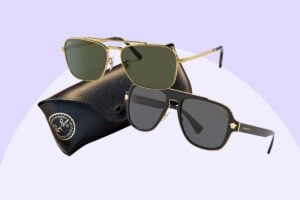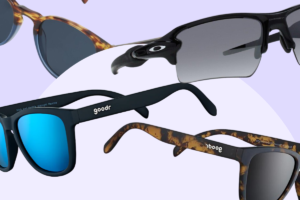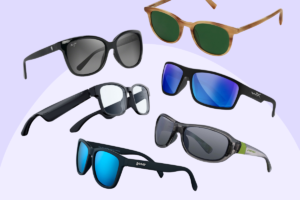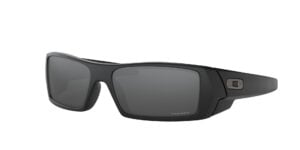The history of sunglasses dates back centuries. Here’s a deep dive into the history of sunglasses, who invented them, and how they’ve evolved.
When Were Polarized Sunglasses Invented?
Polarized sunglasses didn’t emerge until hundreds of years after eyeglasses were invented. It wasn’t until after Foster’s sunglasses were around for a while that science started to develop. Then, sunglasses with features like polarized lenses began to emerge.
Throughout the mid-to-late-1900s, sunglasses started being mass-produced with other features:
- Anti-reflective coatings. This prevents glare from elements like snow and water
- Anti-fog coatings. This stops glasses from fogging up in environments like humidity
- Scratch- and shatter-resistant materials. Certain materials are less prone to scratching or breaking
Where to Buy Sunglasses
Biggest Selection: GlassesUSA
Fastest Delivery: EyeBuyDirect
Best Independent Retailer: Warby Parker
Who Invented Modern Sunglasses?
The first pair of eyeglasses were worn in the late 1200s in Pisa, Italy. The convex-shaped glass resembled small magnifying glasses. While many people credited their creation to a man named Salvino D’Armati in Italy in the 13th century, other names are notable for the invention of eyewear.3
Benjamin Franklin also gets a lot of credit for inventing eyeglasses. They were actually already around for hundreds of years by the 1700s. However, he did invent bifocals in the mid-1700s.3
English Franciscan Friar Roger Bacon can also lay some claim to the creation of sunglasses. He wrote about the scientific principles of corrective lenses back in 1266.6
However, the history of eyeglasses dates back even further. In the year 1000, a mathematician named Abu Ali al Hasan ibn al-Haytham (known in the West as Alhacen or Alhazen) wrote literature that led to him becoming known as the “Father of Modern Optics.”
It wasn’t until after eyeglasses that sunglasses came to life, too. Ayscough is known for inventing the first pair of sunglasses that resemble modern sunglasses.
The History of Sunglasses
Here’s a breakdown of the history of sunglasses.
Early Origins of Sunglasses
The history of sunglasses can be attributed to the Inuits and ancient Chinese. Inuits used walrus ivory to make snow goggles with narrow slits. Not long after, the Chinese made sunglasses out of smoky quartz to help dim the light.1,5
However, similar sunglasses worn today can be traced back to the 18th century. This was when English optician James Ayscough created glasses with tinted lenses. They are lenses with pigmented dye in them to give them color.
The original purpose of sunglasses was multifaceted. While the Inuits wore sunglasses to shield their eyes from the light reflected off the snow and ice, the Chinese used sunglasses for another reason. They wanted to conceal their facial expressions in high-profile situations.
Evolution of Sunglasses in Europe
In the 18th century, Italians in Venice wore green-tinted glasses, known as Goldoni glasses, after the playwright Carlo Goldoni. They wore these dark green lenses to protect their eyes from the sun’s glare off Venetian canals.1
In the 19th century, during the syphilis outbreak in Europe, yellow- and brown-tinted sunglasses started being prescribed to people infected by the disease. Their eyes were light-sensitive, and doctors thought tinted lenses could help.
Modern Sunglasses and Their Popularity
It wasn’t until 1929 that sunglasses were made for mass production, thanks to the advent of new production technology.
The founder of Foster Grant, Sam Foster, created the first affordable sunglasses for the public. Foster sold his sunglasses on the Atlantic City Boardwalk.2
Foster Grant sunglasses developed over the years to become more protective, and sunglasses grew in popularity in movies throughout the mid- to late-1900s. Ray-Ban sunglasses also became popular around this time.
Over the years, the sunglasses market has blown up with all kinds of protective eyewear. Sunglasses have become a popular fashion accessory.
Some ways modern sunglasses are customizable include:
- Colored lenses. Lenses that have pigmented lenses
- Prescription shades. Sunglasses that also correct vision
- Various lens shapes. Different shapes and styles of lenses (like teardrop or cat-eye)
- Interchangeable lenses. Lenses that you can swap out for others
Consumers are spoiled for choice today of sunglasses to meet their personal style and needs, whether they wear sunglasses for fashion, UV protection, or sports.
Summary
Sunglasses have been around for centuries, and eyeglasses have been around for even longer.
Sunglasses weren’t always used for the same reasons that we use them today. And they certainly have changed looks over the years.
Today, sunglasses are a wardrobe staple with both fashion and purpose in mind.
In this article
Best Places to Buy Glasses

Best Overall
Warby Parker has stylish, high-quality frames at affordable prices.

Also Great
Liingo Eyewear is another great option to buy glasses online.

Best on a Budget
EyeBuyDirect has a wide variety of budget frames starting at $6.
Best Places to Buy Contacts

Best Overall
Discount Contacts is our #1 recommendation to buy contacts online.

Also Great
GlassesUSA has a huge selection of contacts, glasses, & sunglasses.







